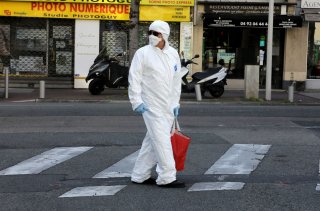by Robin Cohen
 The coronavirus pandemic demonstrates the salience of class to the spread, containment and impact of infectious diseases. The virus hitches a ride on us, the humans who act simultaneously as its hosts and victims. Human mobility and immobility – who can and can’t move and why – is therefore crucial to understanding the virus. And these issues of mobility have significant class dimensions.
The coronavirus pandemic demonstrates the salience of class to the spread, containment and impact of infectious diseases. The virus hitches a ride on us, the humans who act simultaneously as its hosts and victims. Human mobility and immobility – who can and can’t move and why – is therefore crucial to understanding the virus. And these issues of mobility have significant class dimensions.
Some researchers have argued in recent years that we are living through an “age of migration”, characterised by international movements of people. Yet the coronavirus crisis also shows this is an age of involuntary immobility for many people around the world.
One of the earliest cases in the UK of COVID-19, the disease linked to the new coronavirus, concerned a businessman who had contracted the virus in Singapore in January 2020. He passed it to others in a French ski resort, before returning to the UK and spreading the virus in his home city, Brighton. He carried the virus while asymptomatic, so bears no moral responsibility. However, his privileged lifestyle and ability to travel internationally provided the virus with an effective delivery service.
Those who could, moved
In Italy, Spain and France, those who had the means of transport rapidly exited highly infected areas in early and mid-March, some acting as carriers of COVID-19. In Italy, when a draft decree locking down Lombardy was leaked, thousands headed to their extended families in the south. In Spain, a newspaper reported 4km of traffic jams on motorways heading out of Madrid. The Spanish flight was largely to second homes.
In France, Parisians were met at Cape Ferret in south-western France by hostile graffiti. A local lamented on a Facebook page: “It’s very worrying to see all those people fleeing Paris – that will certainly spread the virus.”
American Civil War: Robert E. Lee resigns his commission in the United States Army in order to command the forces of the state of Virginia.
Dan Gavriliu performs the first surgical replacement of a human organ.
The exodus from New York also started in mid-March. One provider of private healthcare fielded 75 telephone calls a day asking whether it would be better to stay in the city or go to the Hamptons, Aspen, St Barts (an island in the Caribbean catering to the wealthy) or Palm Beach. Private jets were charted and some even sought to establish their own ICUs together with ventilators in their second homes.
Forced to flee
Movement by the poor has taken a very different form. As factories, offices and businesses shut, daily-paid and migrant workers were discarded without ceremony. In India, Prime Minister Narendra Modi’s order to lockdown the country from midnight on March 24 provided a traumatic illustration of the plight of the poor. Desperate migrants tried to return to their home areas, with crowded stations becoming giant petri dishes on which the virus could thrive.
At first, the Uttar Pradesh government was sympathetic, sending 1,000 buses to pick up the state’s workers in Delhi. When many returnees were greeted with hostility, the pickup was abruptly stopped on March 31, causing further chaos. In the city of Bareilly, returnees were assembled and sprayed with disinfectant.
Two sides of immobility
In sharp contrast, my wife and I provide a simple example of the privileged immobile. We have a comfortable house and a small garden. We are digitally connected with colleagues, friends and relatives worldwide and have paid for streaming services that keep us moderately entertained. We are able to work from home. Of course, life is weird and unnatural, but we experience no pressing hardship.
The immobility of the poor could not be more different. In Tehran, as economic activities crumpled, about 1.5 million children who made their living from selling commodities such as flowers, cigarettes and chewing gum to car owners and those on public transport suddenly had no means of survival.
In the Johannesburg townships, social distancing is almost impossible, while mass unemployment (already at 30%) resulting from the lockdown may mean mass poverty and even starvation. In Barcelona, there are also notable class differences in infections – in the working-class district of Roquetes the rate is 533 per 100,000, compared with 77 per 100,000 in upmarket Sant Gervasi.
New winners and losers
Any sophisticated class analysis of the pandemic will become more nuanced as more data from around the world emerges. Given the current difficulties of collecting data, the most immediately useful indicators of variation will be infection and death rates according to the socioeconomic characteristics of different wards and districts.
But it’s already apparent that sections of the working class will be impacted differently. A China-wide survey conducted after the Wuhan lockdown found that 75% of truckers had lost their livelihoods, while taxi drivers’ incomes had collapsed. In contrast, many more workers were recruited to deliver food. In other words, COVID-19 creates new winners and losers.
Only the privileged immobile can afford to ride it out. As lockdowns begin to loosen around the world, it’s possible that workers who can prove they are immune will be considerably advantaged. A new form of stratification could arise between “CIs” (certified immune persons) and “DKs” (don’t knows). Becoming a CI might be a chosen strategy for many desperate and impoverished people who may seek to infect themselves and get back to work with a certificate in hand. Perhaps it is an exaggeration to imagine forged certificates of immunity or distinctive CI tattoos. But these are desperate times.
Robin Cohen, Emeritus Professor, Senior Research Fellow, Kellogg College, University of Oxford
No comments:
Post a Comment